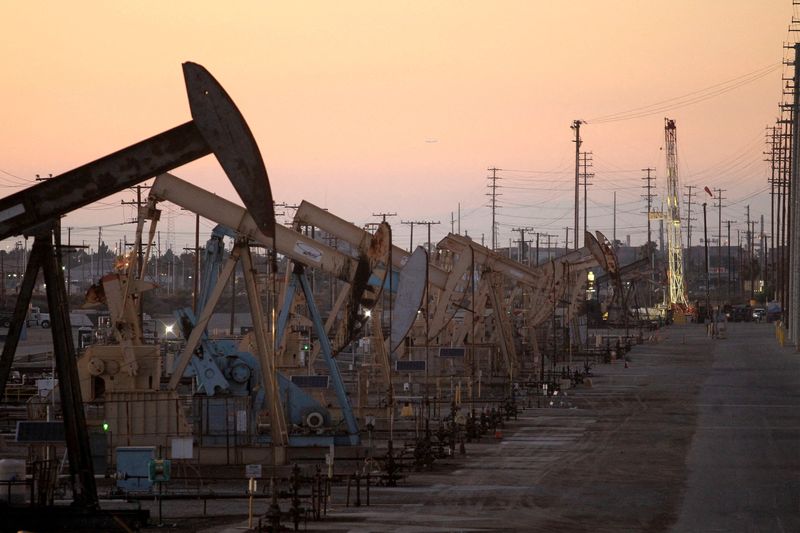
© Reuters. FILE PHOTO: Oil rig pumpjacks, also known as thirsty birds, extract crude from the Wilmington Field oil deposits area near Long Beach, California July 30, 2013. REUTERS/David McNew//File Photo
LCO
+0.34%
Add to/Remove from Watchlist
Add to Watchlist
Add Position
Position added successfully to:
Please name your holdings portfolio
Type:
BUY
SELL
Date:
Amount:
Price
Point Value:
Leverage:
1:1
1:10
1:25
1:50
1:100
1:200
1:400
1:500
1:1000
Commission:
Create New Watchlist
Create
Create a new holdings portfolio
Add
Create
+ Add another position
Close
CL
+0.44%
Add to/Remove from Watchlist
Add to Watchlist
Add Position
Position added successfully to:
Please name your holdings portfolio
Type:
BUY
SELL
Date:
Amount:
Price
Point Value:
Leverage:
1:1
1:10
1:25
1:50
1:100
1:200
1:400
1:500
1:1000
Commission:
Create New Watchlist
Create
Create a new holdings portfolio
Add
Create
+ Add another position
Close
By Paul Carsten
LONDON (Reuters) -Oil prices were little changed on Tuesday as OPEC stuck by its forecast for demand growth this year and next, amid persistent tensions in the Middle East and beyond.
Brent futures for May delivery were up 24 cents at $82.45 a barrel by 1420 GMT. The April U.S. West Texas Intermediate (WTI) crude contract rose 31 cents at $78.24.
On Tuesday, OPEC stuck to its forecast for relatively strong growth in global oil demand in 2024 and 2025, and further raised its economic growth forecast for this year saying there was more room for improvement.
The monthly report from the U.S. Energy Information Administration (EIA) is expected later on Tuesday, while the International Energy Agency (IEA), which advises industrialised nations, is anticipated to put out its estimates on Thursday.
“While we believe the estimates will be largely unchanged, any upside surprise will ease demand concerns,” ANZ analysts said.
However, recent data emanating from China has suggested weakening demand. For the world’s biggest oil buyer, crude imports rose in the first two months of the year compared with the same period of 2023. However, the imports were down from preceding months, continuing a trend of softening purchases.
“Bearish demand sentiment and growing non-OPEC supply leave little room for the market to be bullish on oil prices at this time,” said Serena Huang, head of APAC analysis at Vortexa.
GEOPOLITICAL TENSIONS
Hopes of a ceasefire in Israel’s war against Hamas have faded, with negotiations deadlocked in Cairo while the conflict threatens to widen as Israel and Lebanon’s Hezbollah continue to exchange fire.
Though the Gaza conflict has not led to significant oil supply disruptions, Yemen’s Iran-aligned Houthis have been attacking ships in the Red Sea and Gulf of Aden since November in a campaign of they say is in solidarity with Palestinians.
Airstrikes attributed to a U.S.-British coalition hit port cities and small towns in western Yemen on Monday and the Houthis said on Tuesday that they had fired missiles at what they described as a U.S. ship in the Red Sea.
Traders are becoming inured to such attacks, said John Evans at oil broker PVM.
“The inventory of oil that might be affected is not lost, it is just delayed – and with the new shipping times being part of the new norm, ‘delayed’ will eventually not be applicable,” he said.
“The grind and grind of this war will continue, as will the fall away of its relevance to oil prices.”
In Russia, the world’s second largest oil exporter, a Ukrainian attack on energy facilities set ablaze Lukoil’s NORSI refinery.
Source: Investing.com


























